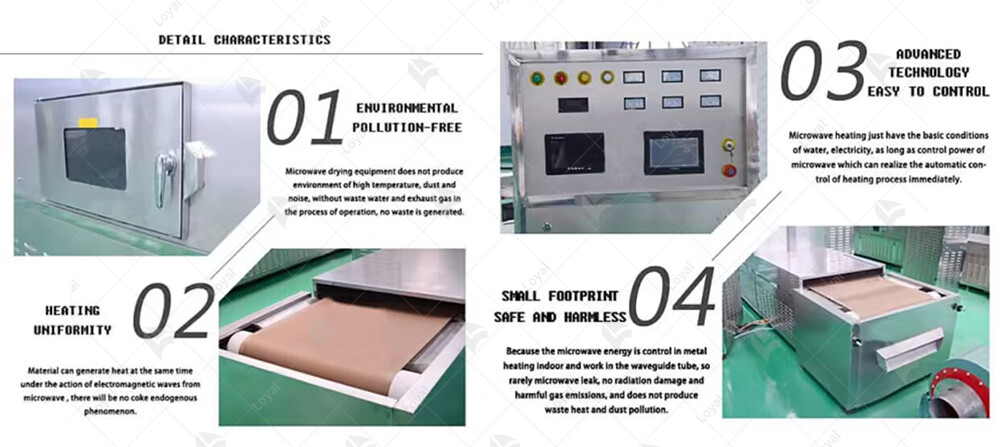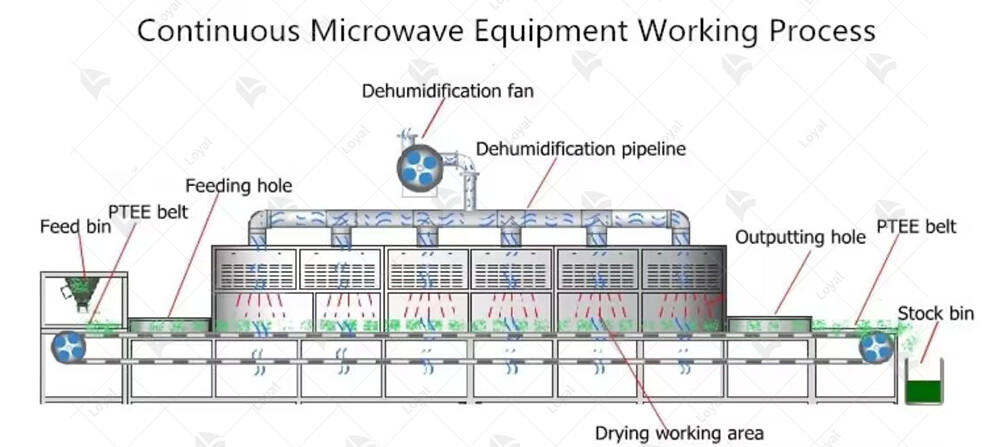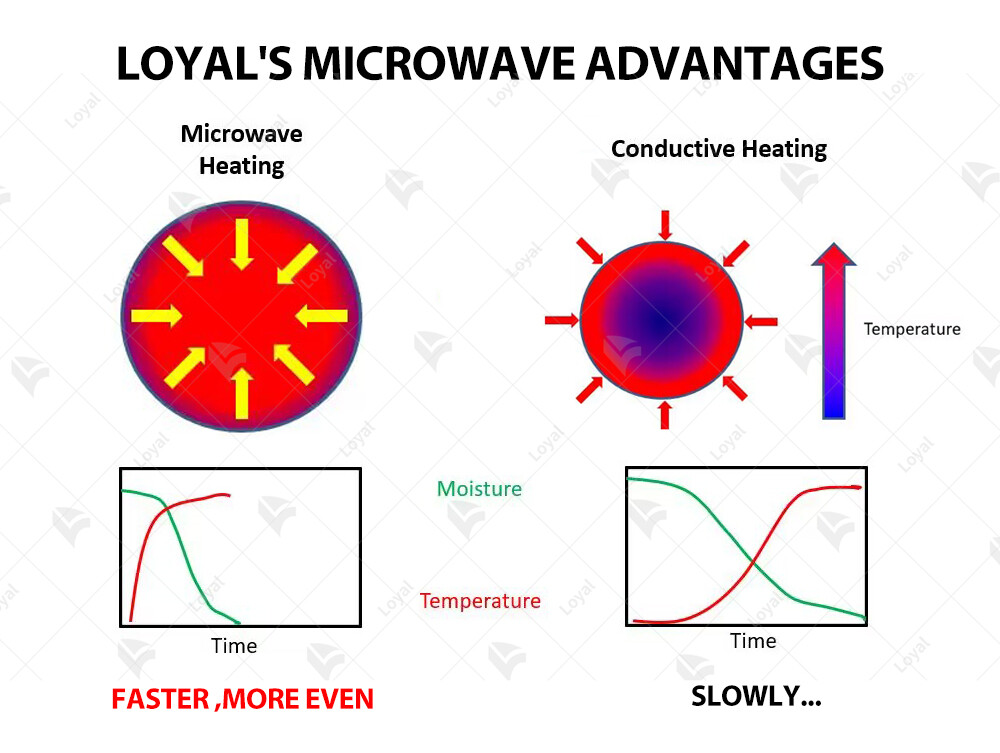The Ultimate Honeycomb Ceramic Filter Industrial Microwave Drying Machine Guide to 2024
Introduction to Honeycomb Ceramic Filter Industrial Microwave Drying Machine
Honeycomb ceramic filters are essential components in industrial processes, particularly in the realm of food processing and drying. These filters, characterized by their intricate honeycomb-like structure, play a crucial role in separating impurities and ensuring product quality. Within the context of industrial microwave drying machines, honeycomb ceramic filters serve as efficient mediums for controlling airflow and moisture removal.
Honeycomb ceramic filters are composed of a network of interconnected channels, typically made from alumina or silicon carbide materials. This unique structure provides a high surface area for filtration, allowing for effective removal of contaminants such as dust, particles, and volatile organic compounds (VOCs). In industrial microwave drying applications, these filters are strategically integrated into the drying chamber to facilitate uniform airflow and optimize moisture extraction from the product.
Industrial microwave drying machines utilize electromagnetic radiation to generate heat within the product, leading to rapid and efficient drying. Honeycomb ceramic filters enhance this process by maintaining a controlled environment within the drying chamber, ensuring consistent airflow and moisture distribution. As the product is exposed to microwave energy, moisture evaporates and is expelled from the chamber through the filtration system, resulting in a quicker drying cycle and improved product quality.

Understanding Honeycomb Ceramic Filter Industrial Microwave Drying Machine
Industrial microwave drying machines are advanced equipment used in various industries for the rapid and uniform drying of a wide range of products. Unlike traditional drying methods that rely on convection or conduction heat transfer, microwave drying utilizes electromagnetic waves to directly heat the product, leading to faster processing times and reduced energy consumption. These machines consist of a microwave generator, a drying chamber, and a control system, all working together to optimize the drying process.
The microwave generator produces electromagnetic waves at specific frequencies, typically 915 MHz or 2450 MHz, which are then directed into the drying chamber. Within the chamber, the product is placed on trays or conveyor belts, allowing for even exposure to the microwave energy. As the electromagnetic waves penetrate the product, they cause water molecules to vibrate, generating heat and promoting evaporation.
The control system of industrial microwave drying machines allows operators to adjust various parameters such as power level, drying time, and temperature to achieve the desired drying outcome. Advanced sensors and monitoring devices ensure precise control over the drying process, preventing over-drying or overheating of the product. Additionally, safety features such as automatic shut-off mechanisms and emergency alarms are integrated to protect both the equipment and personnel from potential hazards.
Overall, industrial microwave drying machines offer numerous advantages over conventional drying methods, including faster processing times, higher energy efficiency, and improved product quality. By understanding the principles behind microwave drying and the components of these machines, industries can leverage this technology to enhance their production processes and meet the demands of modern manufacturing.

The Evolution of Microwave Technology in Industrial Settings
Microwave technology has undergone a remarkable evolution in industrial settings, revolutionizing various processes, including drying, heating, and cooking. Initially developed for domestic use, microwaves quickly found applications in industrial environments due to their efficiency and versatility. In the realm of industrial food processing, the integration of microwave technology has significantly enhanced production efficiency and product quality.
In the early stages, industrial microwaves were primarily used for simple heating processes. However, as technology advanced, their capabilities expanded, enabling more complex operations such as drying. This evolution was driven by the demand for faster, more energy-efficient, and precise methods of food processing in large-scale manufacturing.
Today, industrial microwave technology encompasses a wide range of applications beyond simple heating and cooking. One of the most significant advancements is the integration of honeycomb ceramic filters, which play a crucial role in enhancing the efficiency and effectiveness of microwave drying processes.

Honeycomb Ceramic Filters: Properties and Applications in Microwave Drying
Honeycomb ceramic filters have emerged as essential components in industrial microwave drying machines, offering unique properties that optimize the drying process. These filters are composed of a network of interconnected channels, providing a high surface area for efficient moisture removal from food products.
The key properties of honeycomb ceramic filters that make them ideal for microwave drying include their thermal stability, uniform pore structure, and high porosity. These properties enable them to withstand the intense heat generated by microwaves while ensuring uniform and rapid drying of food products.
In microwave drying machines, honeycomb ceramic filters serve multiple functions. Firstly, they act as moisture absorbers, facilitating the removal of water vapor from the product surface. Additionally, they help distribute microwave energy evenly throughout the drying chamber, ensuring uniform drying and preventing hot spots.
Furthermore, honeycomb ceramic filters contribute to the overall quality of dried products by minimizing the risk of overheating or uneven drying, which can lead to loss of flavor, texture, and nutritional value. Their ability to maintain precise temperature control and moisture levels throughout the drying process ensures consistent and high-quality results.

Advantages of Using Honeycomb Ceramic Filters in Industrial Microwaves
Honeycomb ceramic filters offer several advantages when utilized in industrial microwaves. Firstly, these filters are renowned for their exceptional thermal stability and durability, making them ideal for high-temperature applications within industrial microwave systems. Additionally, their unique structure allows for efficient filtration of impurities, ensuring the purity of the microwave environment and enhancing the quality of the drying process.
Another significant advantage of honeycomb ceramic filters is their ability to facilitate uniform heating and drying. By promoting even distribution of microwave energy, these filters enable consistent processing throughout the entire batch, minimizing the risk of uneven drying or hot spots. This uniformity not only improves product quality but also enhances throughput and efficiency, ultimately optimizing the overall performance of industrial microwave drying machines.
Furthermore, honeycomb ceramic filters contribute to enhanced safety in industrial microwave operations. Their robust construction and heat-resistant properties help mitigate the risk of equipment damage or malfunction, reducing downtime and maintenance costs. Moreover, by effectively trapping contaminants and preventing them from entering the microwave cavity, these filters help maintain a clean and hygienic processing environment, ensuring compliance with industry regulations and standards.

Design Features of Honeycomb Ceramic Filter Industrial Microwave Drying Machine
Industrial microwave drying machines are equipped with several key design features that enable efficient and effective processing of various materials. One prominent design aspect is the incorporation of specialized microwave generators and applicators, which deliver precise and controlled microwave energy to the product being dried. These components are designed to optimize energy transfer and distribution, ensuring thorough and uniform heating throughout the material.
Another critical design feature of industrial microwave drying machines is their construction from high-quality materials that are compatible with microwave radiation. This includes the use of corrosion-resistant metals and non-metallic components that can withstand the intense heat and electromagnetic fields generated during the drying process. Additionally, these machines are often equipped with advanced insulation and sealing mechanisms to minimize energy loss and maintain a stable processing environment.
Furthermore, industrial microwave drying machines are designed with versatility and scalability in mind, allowing for customization to accommodate a wide range of product sizes, shapes, and compositions. Adjustable conveyor speeds, variable power settings, and customizable process parameters enable operators to tailor the drying process to meet specific requirements and optimize throughput and efficiency.
Moreover, modern industrial microwave drying machines are equipped with advanced control and monitoring systems that provide real-time feedback and enable precise regulation of key process variables such as temperature, moisture content, and airflow. These systems facilitate optimal performance and ensure consistent product quality while minimizing energy consumption and waste.

Process Optimization Techniques for Efficient Drying with Honeycomb Ceramic Filters
Optimizing the drying process with honeycomb ceramic filters involves implementing various techniques to maximize efficiency and productivity while maintaining product quality. One fundamental optimization strategy is to carefully control the operating parameters of the industrial microwave system, including power level, frequency, and exposure time. By fine-tuning these parameters based on the specific characteristics of the material being dried, operators can achieve optimal drying results while minimizing energy consumption and processing time.
Another key optimization technique is to ensure proper maintenance and upkeep of honeycomb ceramic filters to maximize their effectiveness and longevity. Regular cleaning and inspection of the filters help prevent clogging and deterioration, ensuring consistent filtration performance and minimizing the risk of contamination or equipment damage. Additionally, replacing worn or damaged filters in a timely manner is essential to maintaining optimal drying efficiency and product quality.
Furthermore, process optimization techniques for efficient drying with honeycomb ceramic filters may involve the implementation of advanced monitoring and control systems. These systems enable real-time monitoring of key process variables such as temperature, moisture content, and airflow, allowing operators to adjust parameters as needed to optimize drying performance and ensure consistent product quality.
Moreover, incorporating intelligent automation and feedback control mechanisms into the drying process can further enhance efficiency and reliability. By utilizing predictive modeling and machine learning algorithms, these systems can analyze data from sensors and actuators to anticipate process variations and adjust operating parameters accordingly, optimizing energy utilization and minimizing waste.

Maintenance and Care Guidelines for Honeycomb Ceramic Filter Industrial Microwave Drying Machine
Industrial microwave drying machines are sophisticated pieces of equipment crucial for various manufacturing processes. Proper maintenance and care are essential to ensure their optimal performance and longevity.
Firstly, regular cleaning is paramount for maintaining the efficiency of industrial microwave drying machines. Honeycomb ceramic filters, integral components of these machines, should be cleaned regularly to prevent blockages and ensure consistent airflow. Use mild detergent and water to clean the filters gently, avoiding abrasive cleaners that could damage the ceramic material.
Secondly, inspecting and replacing worn or damaged parts is crucial to prevent breakdowns and ensure continuous operation. Regularly check components such as magnetrons, waveguides, and seals for signs of wear or damage. Replace any faulty parts promptly to avoid compromising the performance of the machine.
Furthermore, calibration and testing should be conducted periodically to verify the accuracy and consistency of the drying process. Calibration ensures that the machine operates within specified parameters, optimizing drying efficiency and product quality. Implement a schedule for routine calibration and testing, adhering to manufacturer recommendations and industry standards.
Additionally, maintaining a clean and well-ventilated environment around the industrial microwave drying machine is essential for safe and efficient operation. Remove any debris or clutter from the vicinity of the machine to prevent airflow restrictions and potential hazards. Ensure proper ventilation to dissipate heat generated during operation and prevent overheating.

Safety Protocols and Regulations in Industrial Microwave Drying Operations
Safety is paramount in industrial settings, particularly in operations involving high-powered equipment like industrial microwave drying machines. Adhering to strict safety protocols and regulations is imperative to prevent accidents and ensure the well-being of personnel.
Firstly, proper training and education on the safe operation of industrial microwave drying machines are essential for all personnel involved in their use. Training programs should cover topics such as machine operation, emergency procedures, and hazard recognition. Ensure that operators are knowledgeable about potential risks and equipped with the necessary skills to mitigate them.
Secondly, implementing comprehensive safety measures and protocols is crucial to minimize hazards in industrial microwave drying operations. Establish clear guidelines for machine operation, including safety procedures for startup, shutdown, and maintenance. Implement safety features such as emergency stop buttons, interlocks, and protective barriers to prevent accidents and injuries.
Additionally, compliance with regulatory requirements and industry standards is essential to avoid legal liabilities and ensure workplace safety. Familiarize yourself with relevant regulations, such as OSHA standards, pertaining to industrial microwave drying operations. Ensure that the industrial microwave drying machine complies with safety standards and undergoes regular inspections and maintenance.

Future Trends and Innovations in Honeycomb Ceramic Filter Industrial Microwave Drying Systems
The field of industrial microwave drying is continuously evolving, driven by advancements in technology and the demand for more efficient and sustainable drying solutions. Several trends and innovations are shaping the future of honeycomb ceramic filter industrial microwave drying systems.
Firstly, there is a growing emphasis on energy efficiency and sustainability in industrial drying processes. Manufacturers are increasingly adopting advanced microwave technologies that minimize energy consumption while maximizing drying efficiency. Honeycomb ceramic filters play a crucial role in enhancing energy efficiency by facilitating uniform heating and airflow distribution, reducing drying times and energy usage.
Secondly, there is a trend towards the integration of smart technologies and automation in industrial microwave drying systems. Smart sensors and monitoring devices enable real-time monitoring of drying parameters such as temperature, moisture content, and airflow. Automated control systems adjust drying conditions accordingly, optimizing process efficiency and product quality while reducing the need for manual intervention.
Additionally, there is a growing focus on customization and flexibility to accommodate diverse drying requirements across different industries. Manufacturers are developing modular and customizable drying systems that can be tailored to specific product characteristics and production volumes. This versatility enables manufacturers to optimize drying processes for various applications while minimizing downtime and waste.
References
1.Tetra Pak : https://www.tetrapak.com
2.Jinan Kelid Machinery Co., Ltd.: http://www.kldfoodmachine.com
3. GEA : https://www.gea.com
4. MAX Industrial Microwave: https://www.maxindustrialmicrowave.com
5. Marel: https://marel.com
 Telephone :+86-531-55583139
Telephone :+86-531-55583139 WhatsApp :+86 13256674591
WhatsApp :+86 13256674591 Email :
Email :










